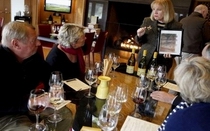
But that is slowly changing, wine marketing executive Brian Baker told more than 250 people Thursday at the Direct to Consumer Wine Symposium in South San Francisco.
"In 1997, there were only 17 states in which we could sell wine," said Baker, vice president of sales and marketing at Chateau Montelena winery. "Today there are 39. And I look forward to the day when I can stand up here and say . . . 'We are able to sell wine in all 50 states.' One day."
Wineries sold $1.46 billion worth of wine directly to consumers last year, up 10 percent from 2011, said Jason Eckenroth, CEO of ShipCompliant, which tracks wine sales. Direct shipments totaled 3.17 million cases last year, he said.
While just a fraction of the industry's overall sales, it is a critical business for many small and mid-sized wineries.
Direct sales enable wineries to bypass retailers and distributors and retain a larger share of the bottle price. It is one reason North Coast wineries like Sonoma-Cutrer work hard to draw customers to their tasting rooms, and hosting events like jazz concerts and croquet games. There, wineries attempt to convert visitors into steady customers, encouraging them to join the wine club and buy regular shipments directly from the winery.
Technology is making it easier to communicate directly. Smartphones are increasingly used in advertising campaigns, especially the use of near-field communications, which enable companies to send messages to possible customers who are driving or walking by. Safeway has been successfully using that technology to draw customers into its stores and direct them to the wine aisle, said Jeff Matisoff, senior vice president of PHD West.
"The advances in mobile access fuel the speed at which our social connectivity takes place," Matisoff said. "Businesses, all businesses, will be changed forever by the continuing dynamic migration to social media in all forms."
Ken Nerlove, owner and grape grower at Elkhorn Peak Cellars, described how he developed a digital "Pinot Noir Chronicles" newsletter with embedded videos and "pinot cams" that showed various stages of the winemaking process. Each email included links where the reader could easily click through to purchase wine.
"I should have done it a long time ago, because every email has been profitable for us," Nerlove said.
As wineries increase the volume of their direct-to-consumer shipments, states are taking a closer look at their laws to make sure they're capturing some of that revenue. They are closely watching "third-party" retailers like Amazon.com and the shipping fulfillment houses some wineries use to ship wine to club members, said Steve Gross, director of state relations for the Wine Institute.
This year, Pennsylvania is likely to pass a law to allow direct shipping, Gross said. Attendees were asked to lobby Massachusetts to encourage direct shipping, and the Wine Institute will be introducing a bill in Utah this year that aims to legalize shipping of wine to that state, Gross said.
"I don't think it has a big chance to pass the first time through, but you have to take baby steps," Gross said.





